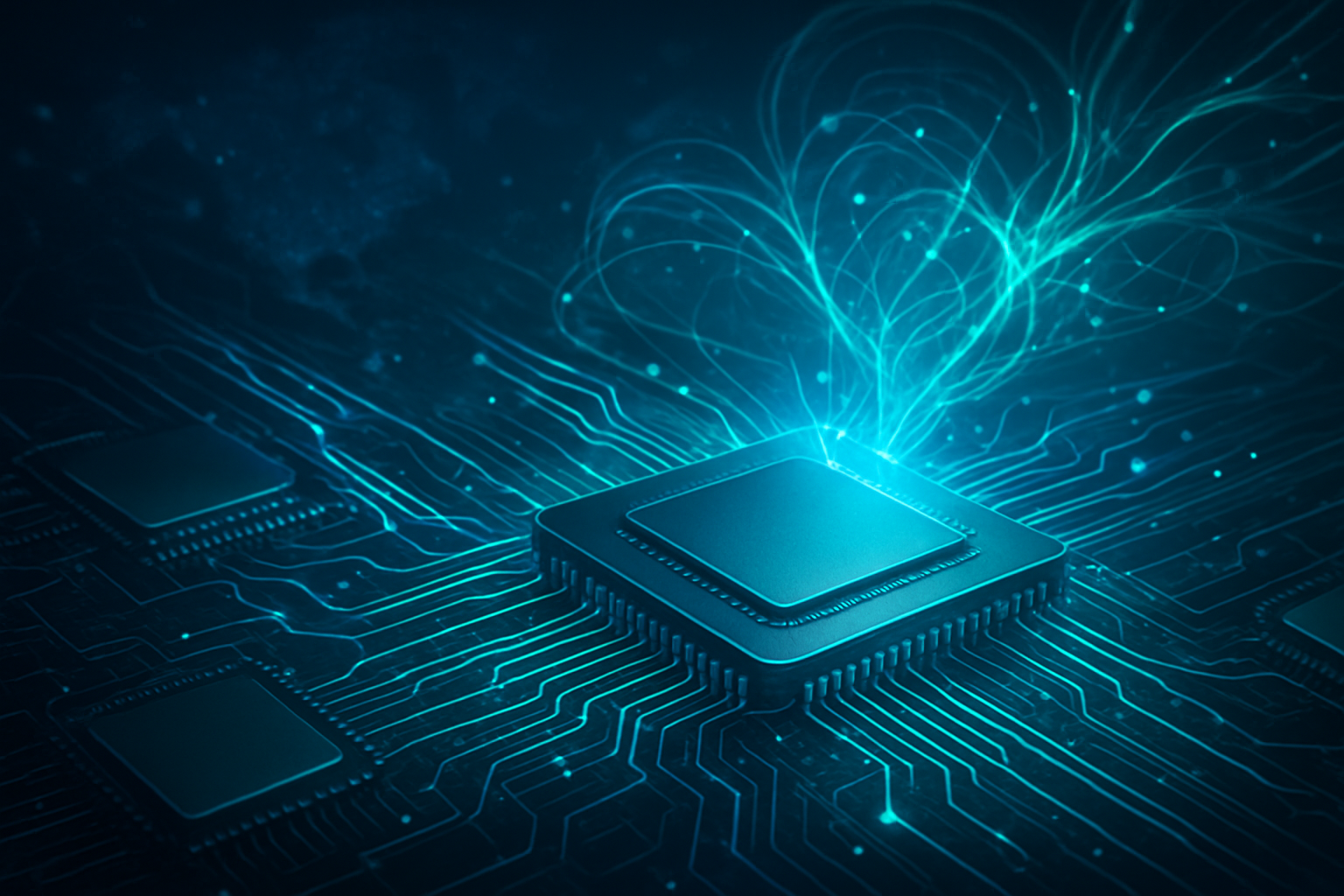The artificial intelligence (AI) sector, particularly AI-related semiconductor stocks, has been a beacon of explosive growth, but recent fluctuations and declines in late 2024 and early November 2025 have ignited a fervent debate: are we witnessing a healthy market correction or the ominous signs of an "AI bubble" bursting? A palpable "risk-off" sentiment has swept across financial markets, moving from "unbridled optimism to a newfound prudence," prompting investors to reassess what many perceive as stretched valuations in the AI industry.
This downturn has seen substantial market value losses affecting key players in the global semiconductor sector, trimming approximately $500 billion in market value worldwide. This immediate significance signals increased market volatility and a renewed focus on companies demonstrating robust fundamentals. The sell-off was global, impacting not only U.S. markets but also Asian markets, which recorded their sharpest slide in seven months, as rising Treasury yields and broader global uncertainty push investors towards safer assets.
The Technical Pulse: Unpacking the Semiconductor Market's Volatility
The AI-related semiconductor sector has been on a rollercoaster, marked by periods of explosive growth followed by sharp corrections. The Morningstar Global Semiconductors Index surged 34% by late September 2025, more than double the return of the overall US market. However, early November 2025 brought a widespread sell-off, erasing billions in market value and causing the tech-heavy Nasdaq Composite and S&P 500 to record significant one-day percentage drops. This turbulence was exacerbated by U.S. export restrictions on AI chips to China, ongoing valuation pressures, and regulatory uncertainties.
Leading AI semiconductor companies have experienced divergent fortunes. Nvidia (NASDAQ: NVDA), the undisputed leader, saw its market capitalization briefly surpass $5 trillion, making it the first publicly traded company to reach this milestone, yet it plummeted to around $4.47 trillion after falling over 16% in four trading sessions in early November 2025. This marked its steepest weekly decline in over a year, attributed to "valuation fatigue" and concerns about the AI boom cooling, alongside U.S. export restrictions and potential production delays for its H100 and upcoming Blackwell chips. Despite this, Nvidia reported record Q2 2025 revenue of $30.0 billion, a 122% year-over-year surge, primarily from its Data Center segment. However, its extreme Price-to-Earnings (P/E) ratios, far exceeding historical benchmarks, highlight a significant disconnect between valuation and traditional investment logic.
Advanced Micro Devices (NASDAQ: AMD) shares tumbled alongside Nvidia, falling 3.7% on November 5, 2025, due to lower-than-expected guidance, despite reporting record Q3 2025 revenue of $9.2 billion, a 36% year-over-year increase driven by strong sales of its EPYC, Ryzen, and Instinct processors. Broadcom (NASDAQ: AVGO) also experienced declines, though its Semiconductor Solutions Group reported a 12% year-over-year revenue boost, reaching $8.2 billion, with AI revenue soaring an astonishing 220% year-over-year in fiscal 2024. Taiwan Semiconductor Manufacturing Co. (NYSE: TSM) shares dropped almost 7% in a single day, even after announcing robust Q3 earnings in October 2025 and a stronger-than-anticipated long-term AI revenue outlook. In contrast, Intel (NASDAQ: INTC), a relative laggard, surged nearly 2% intraday on November 7, 2025, following hints from Elon Musk about a potential Tesla AI chip manufacturing partnership, bringing its year-to-date surge to 88%.
The demand for AI has spurred rapid innovation. Nvidia's new Blackwell architecture, with its upcoming Blackwell Ultra GPU, boasts increased HBM3e high-bandwidth memory and boosted FP4 inference performance. AMD is challenging with its Instinct MI355X GPU, offering greater memory capacity and comparable AI performance, while Intel's Xeon 6 P-core processors claim superior AI inferencing. Broadcom is developing next-generation XPU chips on a 3nm pipeline, and disruptors like Cerebras Systems are launching Wafer Scale Engines with trillions of transistors for faster inference.
While current market movements share similarities with past tech bubbles, particularly the dot-com era's inflated valuations and speculative growth, crucial distinctions exist. Unlike many speculative internet companies of the late 1990s that lacked viable business models, current AI technologies demonstrate tangible functional capabilities. The current AI cycle also features a higher level of institutional investor participation and deeper integration into existing business infrastructure. However, a 2025 MIT study revealed that 95% of organizations deploying generative AI are seeing little to no ROI, and OpenAI reported a $13.5 billion loss against $4.3 billion in revenue in the first half of 2025, raising questions about actual return on investment.
Reshaping the AI Landscape: Impact on Companies and Competitive Dynamics
The current volatility in the AI semiconductor market is profoundly reshaping the competitive strategies and market positioning of AI companies, tech giants, and startups. The soaring demand for specialized AI chips has created critical shortages and escalated costs, hindering advancements for many.
Tech giants like Alphabet (NASDAQ: GOOGL), Amazon (NASDAQ: AMZN), Microsoft (NASDAQ: MSFT), and Meta Platforms (NASDAQ: META) are strategically investing heavily in designing their own proprietary AI chips (e.g., Google's TPUs, Amazon's Trainium/Inferentia, Microsoft's Maia 100, Meta's Artemis). This aims to reduce reliance on external suppliers like Nvidia, optimize performance for their specific cloud ecosystems, and achieve significant cost savings. Their substantial financial strength allows them to secure long-term contracts with foundries, insulating them from some of the worst impacts of chip shortages and granting them a competitive edge in this "AI arms race."
AI startups, however, face a more challenging environment. Without the negotiating power or capital of tech giants, they often confront higher prices, longer lead times, and limited access to advanced chips, slowing their development and creating financial hurdles. Conversely, a burgeoning ecosystem of specialized AI semiconductor startups focusing on innovative, cost-effective, and energy-efficient chip designs are attracting substantial venture capital funding.
Beneficiaries include dominant chip manufacturers like Nvidia, AMD, and Intel, who continue to benefit from overwhelming demand despite increased competition. Nvidia still commands approximately 80% of the AI accelerator market, while AMD is rapidly gaining ground with its MI300 series. Intel is making strides with its Gaudi 3 chip, emphasizing competitive pricing. Fabless, foundry, and capital equipment players also see growth. Companies with strong balance sheets and diversified revenue streams, like the tech giants, are more resilient.
Losers are typically pure-play AI companies with high burn rates and undifferentiated offerings, as well as those solely reliant on external suppliers without long-term contracts. Companies with outdated chip designs are also struggling as developers favor GPUs for AI models.
The competitive landscape is intensifying. Nvidia faces formidable challenges not only from direct competitors but also from its largest customers—cloud providers and major AI labs—who are actively designing custom silicon. Geopolitical tensions, particularly U.S. export restrictions to China, have impacted Nvidia's market share in that region. The rise of alternatives like AMD's MI300 series and Intel's Gaudi 3, offering competitive performance and focusing on cost-effectiveness, is challenging Nvidia's supremacy. The shift towards in-house chip development by tech giants could lead to over 40% of the AI chip market being captured by custom chips by 2030.
This disruption could lead to slower deployment and innovation of new AI models and services across industries like healthcare and autonomous vehicles. Increased costs for AI-powered devices due to chip scarcity will impact affordability. The global and interdependent nature of the AI chip supply chain makes it vulnerable to geopolitical tensions, leading to delays and price hikes across various sectors. This could also drive a shift towards algorithmic rather than purely hardware-driven innovation. Strategically, companies are prioritizing diversifying supplier networks, investing in advanced data and risk management tools, and leveraging robust software ecosystems like Nvidia's CUDA and AMD's ROCm. The "cooling" in investor sentiment indicates a market shift towards demanding tangible returns and sustainable business models.
Broader Implications: Navigating the AI Supercycle and Its Challenges
The recent fluctuations and potential cooling in the AI semiconductor market are not isolated events; they are integral to a broader "silicon supercycle" driven by the insatiable demand for specialized hardware. This demand spans high-performance computing, data centers, cloud computing, edge AI, and various industrial sectors. The continuous push for innovation in chip design and manufacturing is leveraging AI itself to enhance processes, creating a virtuous cycle. However, this explosive growth is primarily concentrated among a handful of leading companies like Nvidia and TSMC, while the economic value for the remaining 95% of the semiconductor industry is being squeezed.
The broader impacts on the tech industry include market concentration and divergence, where diversified tech giants with robust balance sheets prove more resilient than pure-play AI companies with unproven monetization strategies. Investment is shifting from speculative growth to a demand for demonstrable value. The "chip war" between the U.S. and China highlights semiconductors as a geopolitical flashpoint, reshaping global supply chains and spurring indigenous chip development.
For society, the AI chip market alone is projected to reach $150 billion in 2025 and potentially $400 billion by 2027, contributing significantly to the global economy. However, AI also has the potential to significantly disrupt labor markets, particularly white-collar jobs. Furthermore, the immense energy and water demands of AI data centers are emerging as significant environmental concerns, prompting calls for more energy-efficient solutions.
Potential concerns include overvaluation and "AI bubble" fears, with companies like Palantir Technologies (NYSE: PLTR) trading at extremely high P/E ratios (e.g., 700x) and OpenAI showing significant loss-to-revenue ratios. Market volatility, fueled by disappointing forecasts and broader economic factors, is also a concern. The sustainability of growth is questioned amid high interest rates and doubts about future earnings, leading to "valuation fatigue." Algorithmic and high-frequency trading, driven by AI, can amplify these market fluctuations.
Comparing this to previous tech bubbles, particularly the dot-com era, reveals similarities in extreme valuations and widespread speculation. However, crucial differences suggest the current AI surge might be a "supercycle" rather than a mere bubble. Today's AI expansion is largely funded by profitable tech giants deploying existing cash flow into tangible infrastructure, unlike many dot-com companies that lacked clear revenue models. The demand for AI is driven by fundamental technological requirements, and the AI infrastructure stage is still in its early phases, suggesting a longer runway for growth. Many analysts view the current cooling as a "healthy market development" or a "maturation phase," shifting focus from speculative exuberance to pragmatic assessment.
The Road Ahead: Future Developments and Predictions
The AI semiconductor market and industry are poised for profound transformation, with projected growth from approximately USD 56.42 billion in 2024 to around USD 232.85 billion by 2034, driven by relentless innovation and substantial investment.
In the near-term (1-3 years), we can expect the continued dominance and evolution of specialized AI architectures like GPUs, TPUs, and ASICs. Advanced packaging technologies, including 2.5D and 3D stacking (e.g., TSMC's CoWoS), will be crucial for increasing chip density and improving power efficiency. There will be aggressive ramp-ups in High Bandwidth Memory (HBM) manufacturing, with HBM4 anticipated in late 2025. Mass production of smaller process nodes, such as 2nm technology, is expected to commence in 2025, enabling more powerful and efficient chips. A significant focus will also be placed on developing energy-efficient AI chips and custom silicon by major tech companies to reduce dependence on external suppliers.
Long-term developments (beyond 3 years) include the emergence of neuromorphic computing, inspired by the human brain for greater energy efficiency, and silicon photonics, which combines optical and electronic components for enhanced speed and reduced energy consumption. Heterogeneous computing, combining various processor types, and chiplet architectures for greater flexibility will also become more prevalent. The convergence of logic and memory manufacturing is also on the horizon to address memory bottlenecks.
These advancements will enable a vast array of potential applications and use cases. Data centers and cloud computing will remain the backbone, driving explosive growth in compute semiconductors. Edge AI will accelerate, fueled by IoT devices, autonomous vehicles, and AI-enabled PCs. Healthcare will benefit from AI-optimized chips for diagnostics and personalized treatment. The automotive sector will see continued demand for chips in autonomous vehicles. AI will also enhance consumer electronics and revolutionize industrial automation and manufacturing, including semiconductor fabrication itself. Telecommunications will require more powerful semiconductors for AI-enhanced network management, and generative AI platforms will benefit from specialized hardware. AI will also play a critical role in sustainability, optimizing systems for carbon-neutral enterprises.
However, the path forward is fraught with challenges. Technical complexity and astronomical costs of manufacturing advanced chips (e.g., a new fab costing $15 billion to $20 billion) limit innovation to a few dominant players. Heat dissipation and power consumption remain significant hurdles, demanding advanced cooling solutions and energy-efficient designs. Memory bottlenecks, supply chain vulnerabilities, and geopolitical risks (such as U.S.-China trade restrictions and the concentration of advanced manufacturing in Taiwan) pose strategic challenges. High R&D investment and market concentration also create barriers.
Experts generally predict a sustained and transformative impact of AI. They foresee continued growth and innovation in the semiconductor market, increased productivity across industries, and accelerated product development. AI is expected to be a value driver for sustainability, enabling carbon-neutral enterprises. While some experts foresee job displacement, others predict AI agents could effectively double the workforce by augmenting human capabilities. Many anticipate Artificial General Intelligence (AGI) could arrive between 2030 and 2040, a significant acceleration. The market is entering a maturation phase, with a renewed emphasis on sustainable growth and profitability, moving from inflated expectations to grounded reality. Hardware innovation will intensify, with "hardware becoming sexy again" as companies race to develop specialized AI engines.
Comprehensive Wrap-up: A Market in Maturation
The AI semiconductor market, after a period of unparalleled growth and investor exuberance, is undergoing a critical recalibration. The recent fluctuations and signs of cooling sentiment, particularly in early November 2025, indicate a necessary shift from speculative excitement to a more pragmatic demand for tangible returns and sustainable business models.
Key takeaways include that this is more likely a valuation correction for AI-related stocks rather than a collapse of the underlying AI technology itself. The fundamental, long-term demand for core AI infrastructure remains robust, driven by continued investment from major players. However, the value is highly concentrated among a few top players like Nvidia, though the rise of custom chip development by hyperscale cloud providers presents a potential long-term disruption to this dominance. The semiconductor industry's inherent cyclicality persists, with nuances introduced by the AI "super cycle," but analysts still warn of a "bumpy ride."
This period marks a crucial maturation phase for the AI industry. It signifies a transition from the initial "dazzle to delivery" stage, where the focus shifts from the sheer promise of AI to tangible monetization and verifiable returns on investment. Historically, transformational technologies often experience such market corrections, which are vital for separating companies with viable AI strategies from those merely riding the hype.
The long-term impact of AI on the semiconductor market is projected to be profoundly transformative, with significant growth fueled by AI-optimized chips, edge computing, and increasing adoption across various sectors. The current fluctuations, while painful in the short term, are likely to foster greater efficiency, innovation, and strategic planning within the industry. Companies will be pressured to optimize supply chains, invest in advanced manufacturing, and deliver clear ROI from AI investments. The shift towards custom AI chips could also decentralize market power, fostering a more diverse ecosystem.
What to watch for in the coming weeks and months includes closely monitoring company earnings reports and guidance from major AI chipmakers for any revised outlooks on revenue and capital expenditures. Observe the investment plans and actual spending by major cloud providers, as their capital expenditure growth is critical. Keep an eye on geopolitical developments, particularly U.S.-China trade tensions, and new product launches and technological advancements in AI chips. Market diversification and competition, especially the progress of internal chip development by hyperscalers, will be crucial. Finally, broader macroeconomic factors, such as interest rate policies, will continue to influence investor sentiment towards high-multiple growth stocks in the AI sector.
This content is intended for informational purposes only and represents analysis of current AI developments.
TokenRing AI delivers enterprise-grade solutions for multi-agent AI workflow orchestration, AI-powered development tools, and seamless remote collaboration platforms.
For more information, visit https://www.tokenring.ai/.









